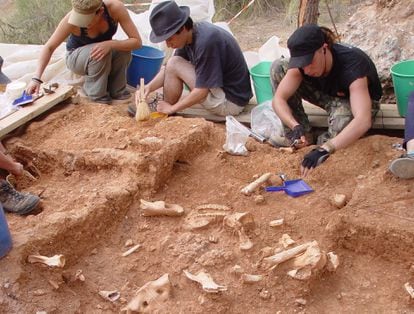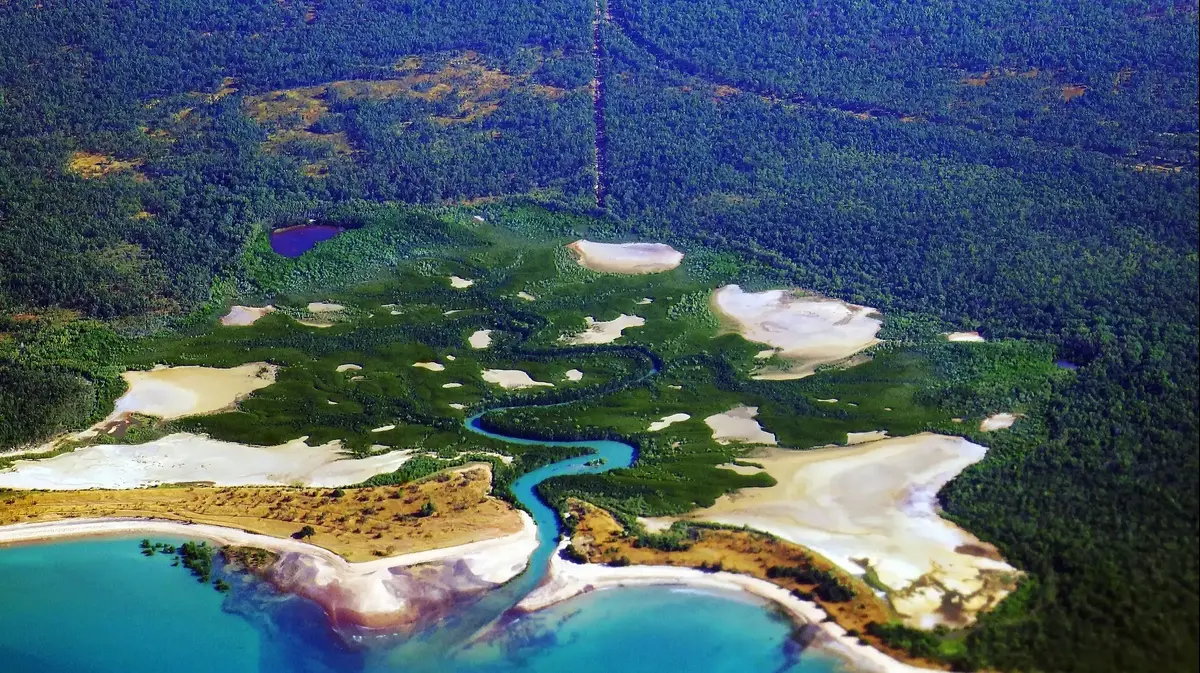39,600 years ago it was very cold in Europe.
The icebergs came down to the Portuguese coast and almost the entire Iberian peninsula was a Siberian steppe where woolly mammoths lived.
The last ice age, that of Würm, was nearing its climax when groups of modern humans, Homo
sapiens
, reached this end of Europe, cornering the Neanderthals.
And they must have done so dressed in tight-fitting skins: at a site near Barcelona they have identified a bone object used, according to a study published today, to perforate and sew leather.
"We already identified it on the ground, it had a series of marks that were not dented by carnivores or cuts or anything frequent," says Montserrat Sanz, an archaeologist at the University of Barcelona.
Together with a group of colleagues, Sanz was excavating in 2007 in a gravel pit located at the confluence of the Canyars and Can Llong streams, a few kilometers from Gavá, where they found the piece.
Located on a river terrace, it must have been a hunting area for hyenas and cats, due to the high concentration of bones from horses, bovids and other herbivores that they found.
But among so many animal bones, they found half a dozen quartz and flint stones carved in a way that only some of the first modern humans who were arriving from the east could have done.
Along with the stones they also found that bone that caught their attention so much.
"Maybe there was a nearby camp or they went through there and left them," Sanz thinks.
Now, microscopic analysis and a series of experiments have allowed its discoverers to determine that it was a tool for sewing skins.
More information
A lock of hair from an ancient shaman reveals how the inhabitants of Menorca already took drugs 3,000 years ago
The piece, about 10 centimeters, is incomplete, which complicates its identification.
But due to its size and shape it should be part of a hip or jawbone of a large herbivore, perhaps a horse or bovine.
Although its collagen is not preserved to be able to date it, with the help of other remains and its location in the stratum in which they found it, they have allowed them to date it: they must have done it about 39,600 years ago, in the middle of the Upper Paleolithic.
The date would fit with the beginnings of the Aurignacian culture, which brought
H. sapiens
to most of Europe.
The special thing about this bone object is the perforations it has.
"On the one hand, it has several groups of perforations, but the most striking thing is the series of symmetrical marks that it has on the other," highlights the Catalan archaeologist.
It is about a dozen parallel and almost equidistant cracks that already intrigued them in 2007 and now they believe they have discovered what they were for.
"From the Upper Paleolithic, burins [a kind of awl] had already been found that must have been used to work the skin, but the base was missing," continues Sanz.
And now they have found it.
"They had already found burins that should be used to work the skin, but the base was missing"
Montserrat Sanz, archaeologist at the University of Barcelona
Key in this discovery was Luc Doyon, an expert in bone archeology at the University of Bordeaux.
Being clear that it was a human work and not the random result of the bites of some animal, it was necessary to determine what it was for.
It could be a decorative or symbolic element.
But Doyon dismisses this: “In the Aurignacian context, ornamental design that imitates natural or clothing features often appears on substantially carved objects.
This is not the case with the Canyars object.
We also rule out that it is a symbolic object because the modifications must be clearly visible and organized to guarantee that the meaning they must convey can be understood by the different members of the group.
Aside from the 10 punctures lined up that are easy to spot,
The excavation of the Canyars stream was carried out in 2007, before an urban project buried the entire area.M.
SANZ / J. DAURA (UNIVERSITY OF BARCELONA)
The study, the results of which have just been published in
Science Advances
, supports these conclusions in a series of experiments using carved bone replicas and stone burins.
“A careful analysis of the 28 holes revealed that they had been made using the same technique, but with at least six different stone tools, suggesting that it was used over a fairly long period of time,” Doyon says.
“By puncturing thick leather samples, we were able to produce punctures with similar rounded characteristics,” she concludes.
Comparing the results, everything indicates that the distribution of the marks on the bone surface was aimed at producing a linear stitch.
The manufacture of custom clothing must have been essential for the survival of Paleolithic people who lived in cold climate environments.
According to marine surveys in the area of the island of Alborán, the temperature in the Iberian Peninsula was more similar to that existing in present-day Siberia than to that of a Mediterranean country today.
At the time of the Canyars site, the average temperature of the coldest month did not rise below -8º, compared to 5º today.
"The key issue for human adaptation to cold environments is to be able to create custom clothing"
To combat the cold, keep skin close to the body warmer.
Traditionally, archaeologists have linked the appearance of tight-fitting clothing to that of bone-sewing-needle technology.
The problem here is that, found in southern Africa around 73,000 years ago and in Siberia and China around 45,000 years ago, the needles didn't reach Europe until around 26,000 years ago.
However, the perforated bone suggests that skins were already being sewn in Canyars some 14,000 years earlier.
Also, bone needles are not strong enough to repeatedly pierce thick leather.
Francesco d'Enrrico, a researcher at the Center for the Behavior of the First Sapiens at the University of Bergen (Norway), defends that "the key issue for human adaptation to cold environments is being able to create tailored clothing."
To sew it, there must have been, like today, different tools.
Perforating the skin and passing a thread through the holes thus produced, possibly by striking the leather with an awl and with a perforated base, would be one of them.
Regarding what was found in Canyars, d'Enrrico wrote in an email: “The needles with an eye are important because they probably represent a refinement of previous techniques.
However, being able to pierce skin to make tailored clothing represents the real turning point in the history of human adaptation."
And in addition to clothing, they also had to sew, shoes, bags or tents.
You can follow
MATERIA
on
,
and
, or sign up here to receive
our weekly newsletter
.




/cloudfront-eu-central-1.images.arcpublishing.com/prisa/4RITWNCKAZFB3I3MBXYYKH6YDI.jpg)
/cloudfront-eu-central-1.images.arcpublishing.com/prisa/DXPUIGHRZZEKNMVHLDNKFJFAMY.jpg)


